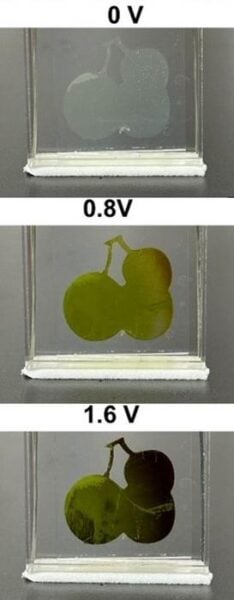Researchers have developed a new electrochromic film design based on metal-organic frameworks (MOFs) that can quickly and reliably switch from transparent to glare-diminishing green to thermal-insulating red, potentially bringing us closer to environmentally friendly ways to keep inside spaces cool. The findings, reported in ACS Energy Letters, demonstrate the potential of these transparent films to regulate indoor temperatures and light, similar to how eyeglasses darken to provide sun protection.
Hongbo Xu and colleagues chose MOFs for their electrochromic film due to the crystalline substances’ ability to form thin films with customizable pore sizes by changing the length of the organic ligand that binds to the metal ion. These features enable improved current flow, more precise control over colors, and increased durability.
Rapid and Reliable Color Switching
In demonstrations, Xu’s MOF electrochromic film took just 2 seconds to switch from colorless to green with an electric potential of 0.8 volts and another 2 seconds to switch to dark red with 1.6 V. The film maintained the green or red color for 40 hours when the potential dropped, unless a reverse voltage was applied to return the film to its transparent state. Additionally, the film performed reliably through 4,500 cycles of switching from colored to clear.
The researchers believe that with further optimization, their tunable coatings could be used in smart windows that regulate indoor temperatures, as well as in smaller-scale intelligent optical devices and sensors.
Advances in Electrochromic Coatings
In addition to Xu’s MOF-based electrochromic film, several other research groups have reported electrochromic coating designs, showcasing the growing interest and potential in this field. These designs include a UV-blocking but visually transparent radiative cooling film, a colorful plant-based film that gets cooler when exposed to sunlight, and a temperature-responsive film that turns darker in cold weather and lighter when it’s hot.
The development of these innovative electrochromic coatings could lead to more energy-efficient and environmentally friendly ways to regulate indoor temperatures and light, reducing the reliance on traditional cooling systems and contributing to more sustainable building practices.
The authors acknowledge funding from the National Natural Science Foundation of China, Natural Science Foundation of Heilongjiang Province, and the Scientific Research Startup Project of Quzhou University. The paper will be available on May 29 at 8 a.m. Eastern time at http://pubs.acs.org/doi/abs/10.1021/acsenergylett.4c00492.
If our reporting has informed or inspired you, please consider making a donation. Every contribution, no matter the size, empowers us to continue delivering accurate, engaging, and trustworthy science and medical news. Independent journalism requires time, effort, and resources—your support ensures we can keep uncovering the stories that matter most to you.
Join us in making knowledge accessible and impactful. Thank you for standing with us!

